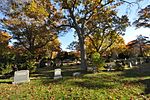Woodwell Climate Research Center
1985 establishments in MassachusettsEducation in Barnstable County, MassachusettsEnvironmental organizations based in MassachusettsEnvironmental organizations established in 1985Environmental research institutes ... and 4 more
Falmouth, MassachusettsResearch institutes established in 1980Research institutes in MassachusettsScience and technology in Massachusetts
Woodwell Climate Research Center, formerly known as the Woods Hole Research Center (WHRC) until August 2020, is a scientific research organization that studies climate change impacts and solutions. The International Center for Climate Governance named WHRC the world's top climate change think tank for 2013, 2014, 2015, and 2016.Woodwell Climate conducts research on the causes and impacts of climate change throughout the tropics, the Arctic, and North America. The Center designs all of its work to inform policy or answer policy questions and is composed of five core units: Arctic, Carbon, Risk, Tropics, and Water.
Excerpt from the Wikipedia article Woodwell Climate Research Center (License: CC BY-SA 3.0, Authors).Woodwell Climate Research Center
Woods Hole Road,
Geographical coordinates (GPS) Address External links Nearby Places Show on map
Geographical coordinates (GPS)
| Latitude | Longitude |
|---|---|
| N 41.5495 ° | E -70.6435 ° |
Address
Woodwell Climate Research Center
Woods Hole Road 149
02541
Massachusetts, United States
Open on Google Maps









